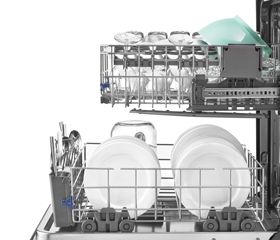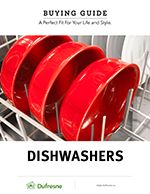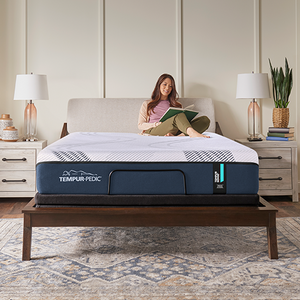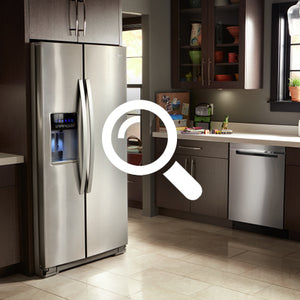Dishwasher Buying Guide
INTRODUCTION
Dishwashers are a great convenience to families but there are a lot of things to consider when choosing which model is right for you. Are you the type of person who only uses your dishwasher for “big loads”? Do you rinse your dishes before you put them in the dishwasher? Do you have to use your dishwasher at specific times of the day? What do you need to know about installing a dishwasher? This buying guide will help you identify features and options to help make your buying decision.

IS SIZE IMPORTANT?
THE ANSWER IS NO AND YES.
No, because all built-in dishwashers have unfinished sides and identical exterior dimensions of a 24" width to conform to kitchen cabinetry standards. Compact 18" built-ins are also available from several manufacturers for smaller kitchens or as a 2nd dishwasher in the house.
Yes, because interior dimensions and layout are vary from dishwasher to dishwasher. Size is more about how many place settings you can get inside a dishwasher and which flexibility options are available. Dishwashers that have a tall tub design allow you to wash those extra-large pots, pans and cookie sheets.
WHAT DO I NEED TO KNOW ABOUT DISHWASHER INSTALLATION?
The first consideration is electrical and water connections. Does your kitchen come equipped with the necessary hookups? If you are replacing an existing dishwasher, chances are that the existing connections will be adequate for your new purchase. However, if you are installing a new dishwasher for the first time or moving the location of your previous dishwasher, you will most likely need to make electrical and plumbing alterations. Can you do this yourself or do you need to hire a professional?
Not all dishwashers come with the necessary Installation Kits. To hook up your dishwasher you need a dishwasher hookup kit that includes a Stainless Steel waterline, connectors and power cord. Make sure you purchase one with your next dishwasher!
It is important to understand that there is a difference between installation and delivery. Delivery generally does not include installation so it is important to have a plan for this. When your new product is delivered you will need to ensure that your old one is already disconnected from both power and water.
WHAT IS IMPORTANT ABOUT STYLE OF DISHWASHER?
New dishwashers come in different styles. How do these styles complement your existing kitchen and other kitchen appliances? Here are some important things to consider.
HANDLES
Handles come in different shapes and styles but the first question you need to ask is do you want them to be visible or not? External bar handles are the most common. Ensure the bar handle shape on the dishwasher matches the bar handle shape of your fridge and stove for a consistent look. This is one reason why you may want to purchase all your appliances from a single manufacturer.
CONTROLS
There are many different types of control options and it is all about what type you prefer. The first is Analog or Digital? Analog uses the old “turn-to-start” control where digital uses push sensor technology. Most dishwashers now use digital to better control the advanced features. The controls for your dishwasher can either be hidden or on the front of the panel. Having the controls visible on the front of the dishwasher gives you instant verification of what stage your dishwasher is at in the cleaning cycle. It can also be tempting for small hands in the household that like to press buttons. Having the control panel hidden on the top edge of the door gives your dishwasher a sleeker look but it also hides all of your indicators. You may want to consider a dishwasher that has time remaining display or other type of indicator if it has hidden controls. Also, most dishwashers that have external handles have hidden controls.
VENTILATION
You need to decide how you want your dishwasher to disperse the steam during the drying cycle. You have two options – from the front or from the top. If it comes out the front, there is a chance it could cause burns or discomfort if small children are around. If it comes out the top, it could create excess moisture within your kitchen cabinets or may cause damage depending upon the construction of your countertop.
COLOUR
What exterior colour do you want your dishwasher to be? Does it need to match your other appliances? You can choose from shades of white, black, stainless-steel, stainless-look and custom panel. You may be wondering what the difference is between stainless-steel and stainless-look. Stainless-steel is a non-magnetic surface and is more difficult to keep clean, especially from fingerprints. Stainless-look has a magnetic surface and is easy to clean. Custom panel dishwashers allow you to attach an insert that makes it look like your existing kitchen cabinets which virtually makes your dishwasher invisible.
WHAT TYPE OF FEATURES SHOULD I BE CONSIDERING?
Make a sound decision. How quiet is your household when your dishwasher is running? Here’s some questions about sound that you should consider:
- Does it bother you today?
- Do you have an open concept kitchen where sound echoes?
- Is your kitchen and dishwasher close to the kids’ bedrooms?
- Is your current dishwasher too loud?
If you answered yes to these questions, other than cleaning ability, a quiet dishwasher may be your #1 consideration. All dishwashers come with some type of sound reduction system but all are not created equal. There are a number of ways manufacturers will make their dishwashers quieter by adding more insulation, using components with less moving parts or a frame base that absorbs vibrations. So how can you tell if one dishwasher is quieter than another? You need to look at the decibel (dB) rating of the dishwasher. A rating of 45 dB or lower is extremely quiet, ratings between 45-50 dB is equivalent to the sound of rain and levels over 50 dB are similar to that of a conversation. Many manufacturers will post their dB levels to help you make your decision.
WHAT OTHER TYPE OF FEATURES SHOULD I BE CONSIDERING?
I just want it clean. First and foremost, rinsing dishes is a thing of the past and actually doing this may negatively affect the performance of your new dishwasher. The cleaning ability of today’s dishwashers far exceed the capability of dishwashers from 20 years ago. The main features you need to compare are types of spray arms, number of jets and options for cycles. Two rotary spray arms used to be the norm, but many of today’s systems use three rotary arms located at the top, middle and bottom of the dishwasher. With dozens of built-in spray jets on the arms, even the most stubborn food particles don’t stand a chance. By adding technology to the equation, you have electronic soil sensors that can monitor the amount of food particles in the dishwasher load and automatically adjust the amount of water and time needed for perfectly clean dishes every time.
How many loads? Many people believe that they use less water and energy by washing dishes by hand, or that they will only use the dishwasher when they have big loads. Today’s dishwashers are extremely energy efficient. Look for rinse only, small load and light load options. Filling your sink or washing dishes under running water will use more water and reduce the quality of your cleaning. The combination of power, heat and dishwasher detergent will create a better and more efficient clean.
Loading your dishwasher. Most people are good at loading their dishwasher to capacity (it’s amazing what we can cram into it). Your new dishwasher might have different racks, different heights or rows of tines (the bars that hold your dishes up). Think about what you use it for every day. Cups, glasses and bowls are the most common everyday item and it’s ok to bring a sample with you to see how they fit. What are the largest items that you wash by hand and why? Did you know that you can put more than just dishes in your dishwasher? How about garbage or recycling bins, some of your children’s toys (especially those that go in their mouths), and of course those pots, pans and cookie sheets.
Look for dishwashers with a tall tub design, adjustable or removable racks to handle those items you tend to wash by hand. Look for dishwashers with adjustable or fold-down tines to handle more cups and bowls. Several manufacturers will advertise that they can accommodate 12, 14, 15 and even 16 place settings at a time. Handling china is a breeze by using a third rack for smaller cups and using a special China/Glass Care cycle which provides a shorter wash and rinse cycle with cooler water.
Stainless on the inside? Some dishwashers have stainless steel on the inside. Why does it make a difference? Stainless steel retains heat better than plastic, so your dishes will dry faster. This allows you to squeeze in one more load before you go to bed. Stainless steel also resists odours and stains so if you happen to have a household that uses hard water, your interior will remain fresher and cleaner. It is also rated to withstand the high temperatures of sanitizing cycles.
WHAT TYPE OF DETERGENT SHOULD I USE?
There are several dishwasher cleaning agents you can use to clean your dishes. You should only use detergents designed specifically for automatic dishwashers. Other types can cause excess suds which may result in suds and water spilling onto your floor.
Dishwasher soap uses enzymes to break down food for better cleaning and it’s available in several forms. Powders tend to be the most economical but can be messy to handle. Tablets are more expensive but are very convenient as you just drop them in - no muss, no fuss. Gel soap is a good third alternative which is mid-priced between powder and tablet and still easy to use. The choice is yours!
As a general rule, harder water and cooler water will require more detergent to clean properly. And conversely, softer water and hotter water will require less detergent.
The rinse aid dispenser in the dishwasher doesn’t rinse but really dries dishes. The dispenser holds a special solution known as a surfactant that spreads water thinner so that it rolls off your dishes and, as a result, dries faster. Depending on your water quality, this could help prevent spotting. Most dispensers have an indicator window to let you know when it’s time to fill up.

























